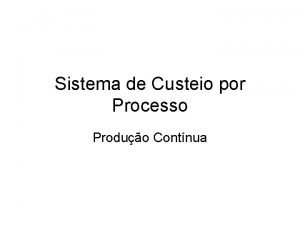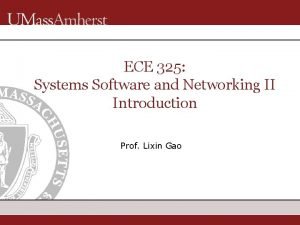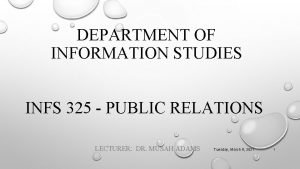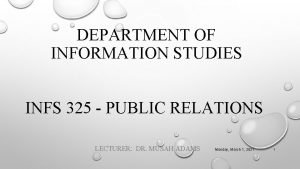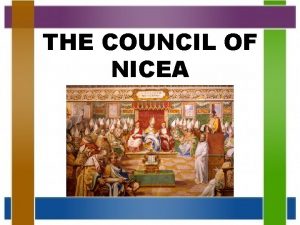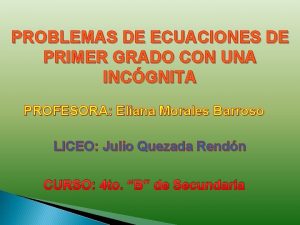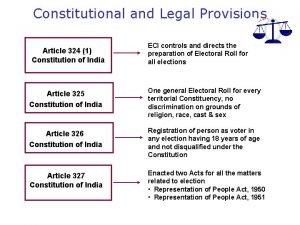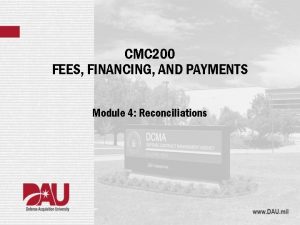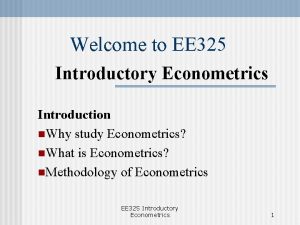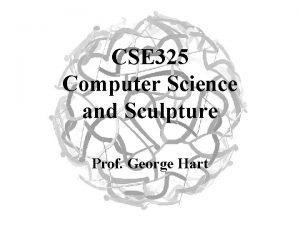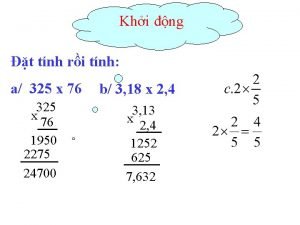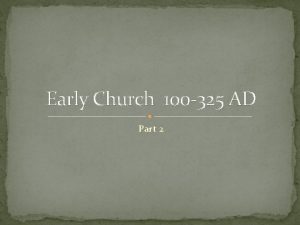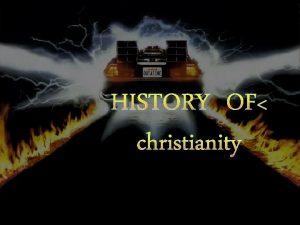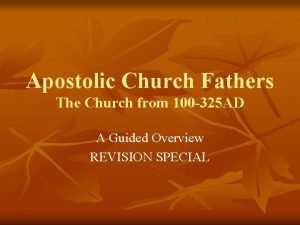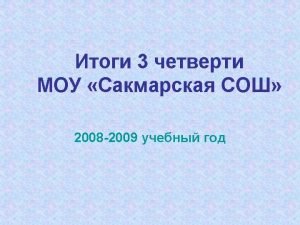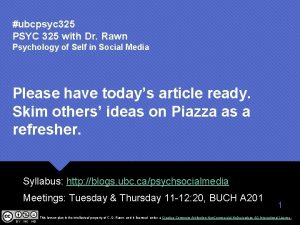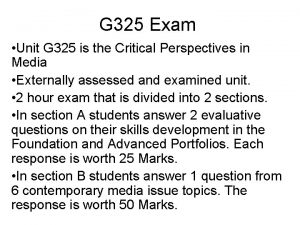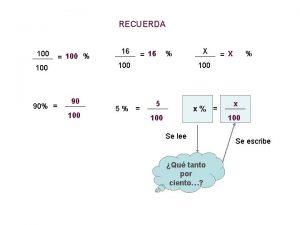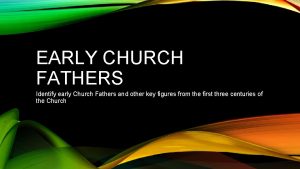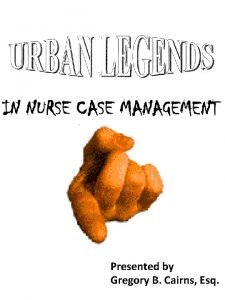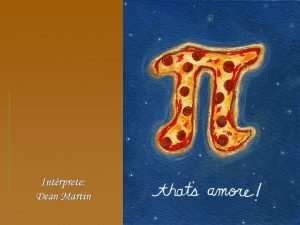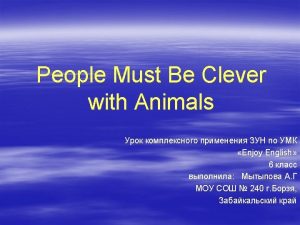Early Church 100 325 AD Part 2 Gregory





















- Slides: 21

Early Church 100 -325 AD Part 2

Gregory of Thaumaturgus (“wonderworker”) (213 -270) in Pontus �Student of Origin in Alexandria �Orator and master teacher �Made bishop of Caesarea with only 17 followers (10 was required to have a bishop) at 40 yrs old � 13 years later when he was 53 there were only 17 unconverted

Controversy and Missions � Divergent views led to constant debates, not evangelism � Judaizers, Docetism, Gnostics, Marcionism, Montanists, Monarchians, Novatimists, Donatists, Arians, Nestorians, Monophysites (Eutychianism and Apollinarism) 1. Gnostics: � Matter is evil – � Spiritual knowledge, esp. of God, is good � Mystical � Led to asceticism and monasticism Montanism: charismatic-prophetic movement 3. Arianism: Rejection of trinity; Christ is created being � With no agreement as to who Christ was, evangelism became an argument of Creeds � Conversion meant the acceptance of a Creed 2.

Gnostics � A “knowledge” that is mystical, secret, higher, intuitive or divine and existential -- as opposed to knowledge that is learned, episteme, beliefs and assumptions from evidence outside of one � Oriental mystic syncretism + Greek philosophy + Judaism � Dualistic: Christ was an emanation or emissary of light from the Kingdom of Light who appeared in a body � Material, matter, flesh, and creation are all evil � Non-tangible, spiritual and mystical are good � The mythological-cosmological drama of a divine element “falls” into the material realm, lodging in a human, then seeks to return to the divine realm through a process of awakening (thus salvation). Thus individual redemption is elevated to cosmic significance. � Manicheanism is the Persian gnostic school version of Augustine � Died as a religion, but concepts infected Catholicism by asceticism, monasticism and distinction between clergy/laity. � Bogomils, Paulicians and Cathars adapted much Spread of Manichaeism 300 -500

Montanus (AD 150), Phrygia � Claimed the return of prophecy and miracles in the continuation of revelation and ecstatic experience and Montanus was Paraclete � Oneness view of God � Montanus and 2 prophetesses, Priscilla and Maximilla, prophesized in ecstatic trances, that New Jerusalem would be in Pepuza in Phrygia � Condemned in Synod of Iconium in 230 � Tertullian was his disciple migrated to N Africa � Wrote against Gnostics � Taught the substance of the Church was the Spirit, not the episcopacy, nor the sacraments. � Teacher of Cyprian, professor of Augustine

Arianism (318), Arius Bishop of Alexandria, Egypt Alexiandria �Accused of reviving an old heresy of Montanus (150) and Sebellius (215) who taught the oneness of God who appeared in different forms – Oneness doctrine of United Pentecostals today �Arius doubted the Trinitarian view of God, which had been view of Church for 300 years – � Stated there was a time when Jesus did not exist �Challenged by Athanasius, archdeacon of Alexandria because controversy was splitting the church �In 321 removed from bishopric, but controversy forced Council of Nicea 325 and continued in the East

Nestorius (386 -451) � Attempted to find a middle ground in the trinity issue: Accused of teaching against the incarnation: the divine could not have part of human nature or suffering of Christ; � He said Christ was two different persons (one divine, one human, unmingled everlastingly united in one body). He was accused of denying the incarnation or the God suffered. � Refused to call Mary, “the mother of God”, (Theotokos, “God bearer”) rather he said, “mother of Christ” (Christotokos) or Mother of just His human side, not the divine. � Controversy led to Council of Ephesus in 431 � Union of human and divine in God-Man was necessary to make the payment to satisfy the penalty for an infinite number of human sinners. � Condemned at Council of Ephesus before his defense from Antioch could arrive! � 17 other bishops agreed with Nestorius and were deposed. � Later the emperor Theodosius II changed his support of Nestorius to exile him to a monastery in Egypt.

Nestorians, the untold heros � The Nestorian church split off from Western Byzantine Church and was accepted in the East, Assyrian Church � Persecuted by Syria, they found refuge in Persia (462); their school of theology was transferred from Edessa to Nisibis, Persia, when closed by emperor in 489. Later modifications moved back toward Catholicism. � They became the greatest missionary church of all time, spreading to China, Mongolia and Korea by 635 � “They expanded rapidly. Asia was widely covered by missionaries. They had no fund to support their mission stations financially; there were no mission boards to direct their activities…Yet they carried the torch of the Gospel all across the vast Asian continent, at the cost of great personal suffering and often martyrdom, for untold numbers of laymen and clergy alike were let by the Holy Spirit to push the frontiers of the Kingdom of God far and wide…The missionaries traveled on foot; they had sandals on their feet and a staff in their hands, and carried a basket on their backs, and in the basket were the Holy Writ and the Cross. They took the road over deep rivers and high mountains, thousands of miles. On their way they met many heathen A Chinese nations and preached to them the gospel of Christ… Around the monument to fourteenth century, this missionary enterprise started to decline. Nestorian There was persecution, deception, extermination by Mongols. ” missionaries in (Professor P. Y. Saeki, Waseda Univ. , in Tokio) 635

Missionary Methods of Ante. Nicean era �Public preaching �Teaching new converts and leaders in the churches �House churches �Oral witness and personal testimony �Personal contact with changed believers �Public testimony before threatening tribunals �Social actions of compassion

State Religion Remains of Imperial palace at Milan � Edict of Tolerance (311) ended the Diocletian persecution. This was an indulgence � Edict of Milan (313) officially legalized Christianity by Emperors Constantine (West) and Lucinius (East) � Confiscated properties returned � Motive was “so that public order may be restored and the continuance of Divine favor” � Christians at first were free to practice religion � Theodosius I (347 -395) made Nicene Christianity the official religions in 381, which included the co-equality of the Spirit 10

Council of Nicea (325) Nicaea or modern Iznik � Arian (non-Trinitarian) controversy disrupted the unity of Empire � If Christianity was the unifying religion of the Empire, then all Roman Christians must believe the same way � Arianism appealed to pagan theologians and emperors who held that Christ was a created Being, inferior to the Father. Their oneness is only in thought and will, not in a unity. � Bishops were given the power to decide and enforce decision � Athenasius, archdeacon from Alexandria, was key factor against Arianism, who felt any means was justified to repress the Arian heresy � Christ was defined as truly God and truly man � Later Arian Emperors, (Constantius II, Valens, including the Gothic, Vandal and Lombard emperors) would reverse this decision, exiling Athenasius 11

Chalcedon Results of Nicean Council (325) and Chalcedon (451) (Bithynia) � The gospel became a God-activity and offered good-news that God effected a perfect salvation � Much of Eastern Christianity was cut off � Assyrian Church, Persian Church, Armenian Church, Syriac Church, Coptic Church, Indian Church, etc. over Christology � Most Oriental (Eastern) Orthodoxy held to Miaphysitism (in the one person of Jesus Christ, Divinity and Humanity are united in “one nature” (physis). � Considered a form of Monophysitism (which the Oriental Orthodox churches reject as well as Chalcedon Council) � Future Arian emperors would seek to reunite these groups � Christianity and the will of God became identified with the will of the state 12

Post-Nicean Church � Government favor brought Government involvement Ruins where Nicean Creed was affirmed � Government used the Church to Christianize (or Romanize) fringe elements, frontier people groups inside and outside the Empire � Immigrants were forced to become Christian to become Roman – often enforced with the sword � Non-Trinitarian Christians fled to East � “Conversion” to Christianity was equated to becoming a Roman citizen � The Parochial system of Roman government was applied to the Church � Divided the Empire into parishes � By 400 this was established from Italy to France � Just before Constantine’s death, he attempted to reinstate Arius, but he died before he could and exiled Athanasius. � Confusion continued with various Arian emperors that followed. Photo used with permission from http: //www. pbase. com/osmantanidik/image/56992742 13

Bibles � 50 valium Greek Bible ordered for churches in Constantinople � Codex books written in uncials (1” high, capital letters) � Minuscules (small letters) not introduced until 750 and not fully replaced until 1050. � Hundreds of MSS assured people would hear God’s Word in churches � By 367 final agreement on NT canon (of 27 books) � By Synod of Rome (West) (382) and Synod of Carthage (East) (397) an undisputed canon of Scripture was agreed upon � Now people had a canon of authority to base their faith � In 405 Jerome translated an approved Bible into Latin 14

Growth in 5 th and 6 th centuries Humiliation of Arius at Nicene 325 � With approval and mandate of the emperor to convert the Empire, the churches grew beyond ability to control, train and organize. � Arianism (often the belief of emperors and army) was opposed by Athanasianism � Evangelism was replaced with political alignment and political correctness and creedal acceptance � Mandated no restriction to church membership for the unity of the empire, that is, the bishops were order to accept everyone without discrimination of beliefs. 15

Monastery Movement begins � Men seeking freedom from temptation to live and be holy to God in isolated environment to gain acceptance � By 346 there are 500, 000 monks in Egypt (7% of pop. ) � Plagues wiped out most of them � John Cassian traveled to Egypt – learned skill of interpretation/meditation as well as the 4 -fold interpretation � Started monasteries with this method � “Evangelism” was dependent on itinerary monks from monasteries who preached in open air 16

Contemporary Orthodox Monasticism goals The monastic rule has as its strength to safeguard the monk in his daily life, helping him, through obedience, to keep unceasing vigil upon his inward integrity so that the union of heart and spirit may become for him a reality and lead him, as far as this is possible upon earth, to union with God. It is the primary rule of the order of Offices and also covers the obedience of intellectual and manual work. Work is itself a prayerful activity with the ascetic end in view of overcoming our rebel nature and to keep us from idleness which is so harmful to the spiritual life. Hagiography, icon painting, Byzantine music, woodcarving, incense preparation, making Church vestments, translating or writing books on the spiritual life and printing them, all arts that originated in Byzantium are still performed and flourish in the Monasteries. 17

Key Missionaries in post-Nicean Period � Martin of Tours (d. 397) – Itinerating missionary in Gaul � Army to monastery to missionary in Gaul � Ulfila (d. 383) – Homoean (the Son was “like” the Father) Arian Missionary to Goths Ulfila 311 -382 � Commissioned a bishop to Goths (Visigoths) in Romania by emperor, Constantius II, son of Constantine, who was Arian � Note: Goths were chief source of mercenary troops for the Empire � Created German alphabet and first Bible translation in Visigoth � Ambrose, govenor of Milan, elected bishop to stop Arian riots – Teacher of Augustine of Hippo � One of 4 great doctors of Catholic Church – creator of doctrine (Jerome, Augustine, Pope Gregory the Great) – the 4 doctors of the Eastern church (Athanasius, Chrysostom, Basil and Gregory of Nazianzus). � Persuaded Pope to accept Mariolotry, Immaculate Conception, and fought Arianism � Composed the hymn, “Praise God from whom all blessings flow” as Arian soldiers were about to attack his church. They were unwilling to attack a hymn-singing church! � John Chrysostom – Archbishop of Constantinople � Funded schools to train native Gothic missionary evangelists � Sent many missionaries to pagan lands and wrote defending Great Commission 18

Patrick of Ireland � British youth captured in raiding party by Irish � Enslaved for six years then allowed to return to Britain, but captured by French pirates and enslaved � Escaped to Britain, where he saw a vision of an Irishman inviting him to come back � Secured permission of the king for religious tolerance � In 15 yrs most of Ireland heard the gospel � Strategy was to win the leaders of a people, then through them, the people would follow. � Celtic converts were given intensive training and ministry involvement (lay movement was their strength) 19

Romanian monastery Missionary Methods � Monasticism: Rule of St. Benedict (547) became the norm: � In Benedict’s rule the monk’s entire waking day, roughly seventeen hours, was divided among three activities: manual labor, the prayerful reading of Holy Scripture (lectio divina), and choral prayer, especially the praying of the Psalms. Even while the monk ate his sparse meals each day, he listened to one of his brothers reading Holy Scripture. � The monks and nuns pursued their goals – purity of heart and the gift of constant prayer – by ingesting massive daily dosages of Scripture. They gave themselves total to God not only by denying themselves and serving others, but by allowing themselves to become saturated in and absorbed by the power of God’s Word. Monks took seriously that principle of Jerome of Bethlehem (347 -419) who said, “To be ignorant of the Scriptures is to be ignorant of Christ” � Witness of Lay People: merchants, soldiers, captives and travelers � Apologists – now given official sanction and freedom to publish especially against the heresies resulting from pagan infusion 20

Doctrinal Controversies in West � Pelagianism: Original sin did not affect human icon of Christ nature – man responsible to choose to be good enough. Oldest (6 cent), St Catherine’s for salvation monastery, Mt Sinai � Icons (between 4 th-8 th cent a constant debate to use icons) until forbidden by Leo III between 726 and 730. The 7 th Ecumenical Council anathemized any veneration of images as idolatry in 787, but restored by Empress Theodora around 850 � Authority of the bishop of Rome (Leo I claimed Petrine Primacy and thus the supremacy of bishop of Rome by 450 � Salvation by trust in the Church and/or sacraments. Keys given to Peter � Penance and good works � Salvation through the sacraments alone � Eastern Church struggled with deity of Christ and Western Church, with the means of salvation Bishop of Rome’s cathedral th 21
 100 100 100 100 100
100 100 100 100 100 325/100 simplificado
325/100 simplificado Ece 325
Ece 325 Apes 325 template
Apes 325 template Infs 325
Infs 325 Infs 325
Infs 325 Infs 325
Infs 325 Peripheral and interfacing
Peripheral and interfacing Council of nicea 325
Council of nicea 325 Un hombre deja una herencia de 16500
Un hombre deja una herencia de 16500 A box of books weighing 325 n
A box of books weighing 325 n Legal provisions
Legal provisions Dcma etools
Dcma etools Methodology of econometrics
Methodology of econometrics Doc pro star
Doc pro star A box of books weighing 325 n
A box of books weighing 325 n Cse 325
Cse 325 Cpsc 325
Cpsc 325 A325n bolts
A325n bolts A 325
A 325 Principezinho
Principezinho 325 ad
325 ad

